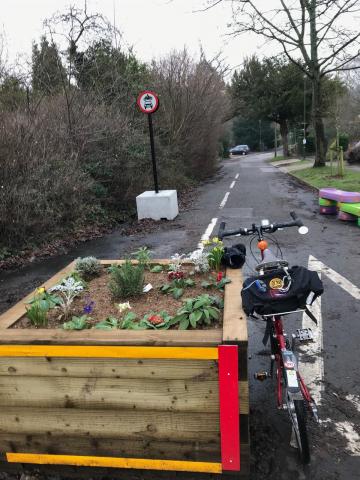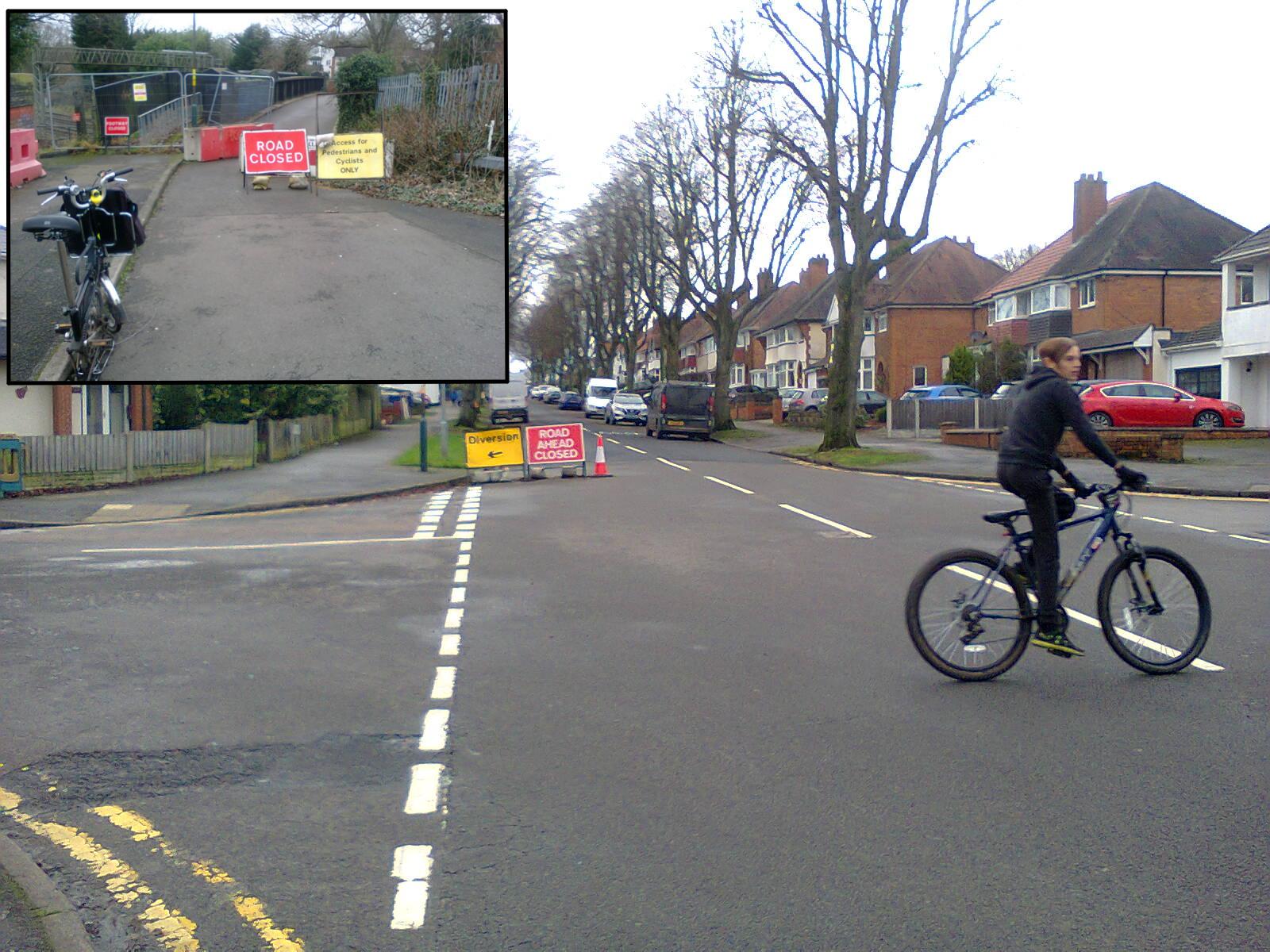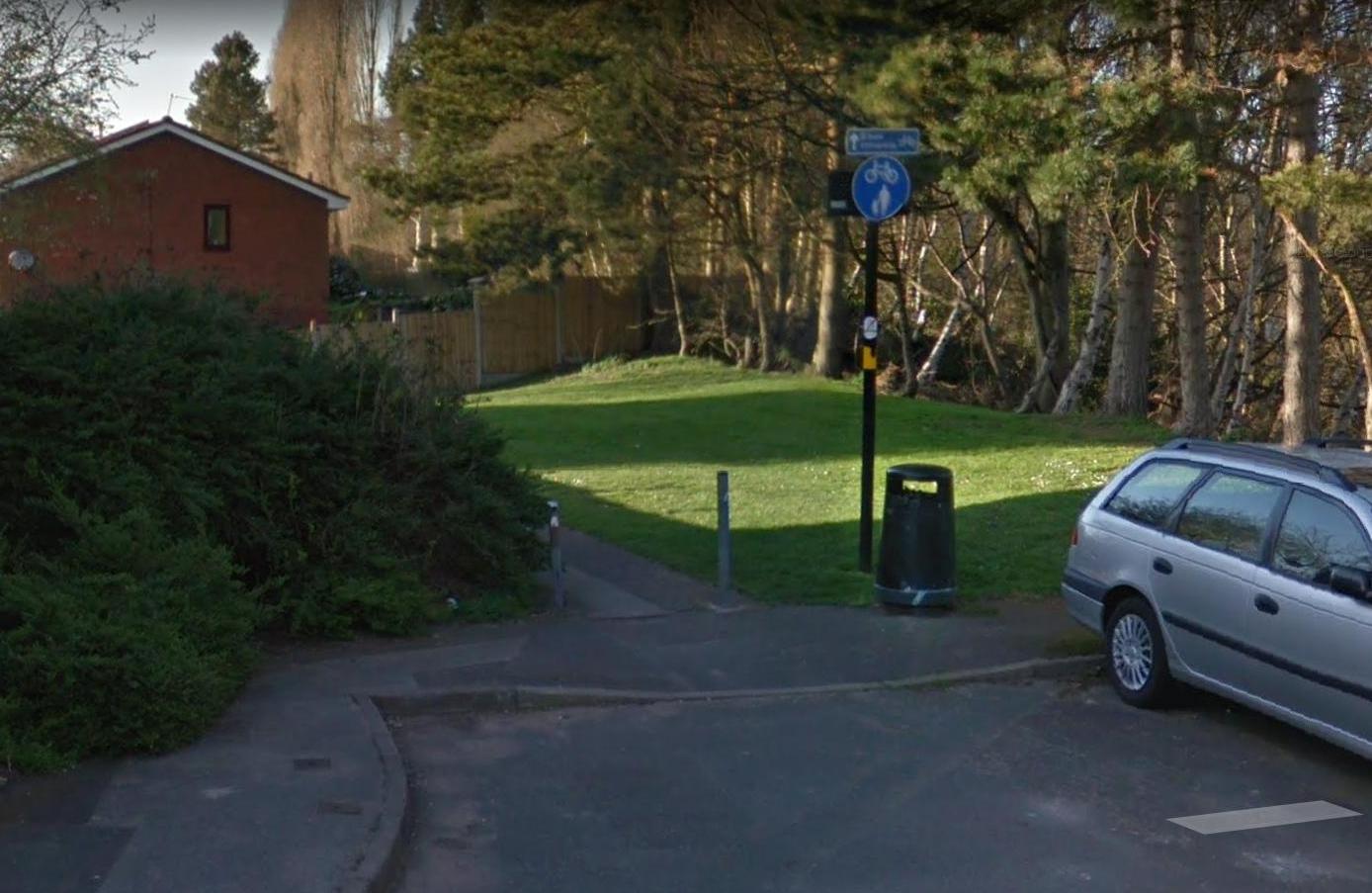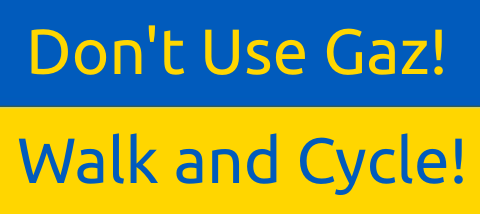
Low Traffic Neighbourhoods aka Birmingham's new "Places for People" have long been known about in cycling campaign circles often under the rather nerdy title of "filtered permeability". The idea of using street design, bollards and planters to physically filter out through traffic, can be found in many established residential areas sometimes by design (Cheddar Rd B11, Bottetourt Rd B29) or less successfully with unenforced no right turn signs (Cecil Rd B29). Residents, visitors and delivery drivers can still drive into an area but can't use these streets as "short cuts" or "the back doubles".
In a prescient blog on this Website, Robert did a design for an LTN in Weoley Castle, and then welcomed these ideas being taken up again in Birmingham last summer.
Push Bike members have been to the Netherlands to see whole cities designed around these principles. In the UK, London has led the way with major innovative Mini-Holland schemes pioneered in boroughs like Waltham Forest, Enfield, Hackney and funded by Transport for London grants to improve walking, amenity, shopping and also cycling in local areas.
For too long, as car ownership and usage has boomed, the extra traffic volumes have been accommodated through the use of residential streets by commuters, van drivers and those using satnavs to find the "faster routes" that try to avoid congestion. While this gives some satisfaction to impatient drivers, and may or may not save them time, it means that residential streets are being used by volumes of traffic they were not designed for. Combined with the narrowing effect of so many cars being parked on the same streets this creates a real and perceived danger for children, people who want to cycle and for pedestrians. The effect is to restrict residents lives and expose them to road danger and traffic fumes. Meanwhile the main roads built to accommodate high traffic loads with parking restrictions, traffic lights, pedestrian crossings and multi-lane junctions, while busy and congested at peak times, have not seen journey times increase greatly in recent years.
In response to the COVID pandemic, in July 2020 the English Government published ambitious proposals to encourage more active travel for local journeys with the Gear Change report, Local Traffic Note 1/20, Two Tranches of Emergency Active Travel Funding and a proposal to set up Active Travel England to set standards and inspect the quality of active travel provision. These two documents are superb and highly recommended.
Birmingham produced an Emergency Transport Plan and the government's own criteria were very supportive of our campaigns: that the package of measures should lead to "lasting change"; should move "as swiftly as possible" and that proposals should "meaningfully alter the status quo". Rapidly implemented LTNs and Pop-Up cycle lanes were required through Experimental Traffic Orders and by December 2020 we had some Tranche One schemes in place. So what do they look like?
The 2020 LTN experience with Lisa Jones "Influencer" at Eco Birmingham
Lisa Jones' @MyBikeAdventure Twitter account with its great pictures has celebrated her cycling in and around Birmingham for a couple of years now. A member of Cycle Birmingham (Push Bikes' Rides Group,) Lisa reports on her rides on and off road, meet ups for pre-COVID Cycle Commuter breakfasts and led rides with groups of new and experienced riders. Now working with the excellent Eco Birmingham Charity, in this blog Lisa rides around the first wave of Birmingham LTNs sampling the benefits they bring etc. So just follow this link to get an excellent summary and great pictures of the first stages of Places for People in Birmingham.
A bit later in December, the intrepid Lisa did a similar ride around some of the "Pop-up" cycle lanes introduced to help key workers get around the City by bike when use of public transport was limited by social distance requirements. This is an excellent account of the current state of these lanes - enjoy !! And many thanks to Lisa and Eco Birmingham.
Our Bournville and Push Bikes LTN Zoom Sessions
 Although some of the Push Bikes Campaign Committee were shielding and our Chair was staying outside the City, thanks to the wonders of Zoom, Teams and Google Earth we carried on with our work and got to grips the LTN/Places for People part of this wonderful opportunity. Across parts of the City local residents' groups also began to come together. A few were well established residents' groups with experience of organising and lobbying around amenity and safety issues. Others had grown up with parents pushing for School Streets and Safer Routes to Schools or for Play Streets and Active Streets initiatives. One group had mobilised around particularly egregious examples of rat-running which made a stretch of pavement unsafe for pedestrians. Meanwhile, COVID restrictions led to newer What's App groups offering advice and social support often on a street-by-street basis.
Although some of the Push Bikes Campaign Committee were shielding and our Chair was staying outside the City, thanks to the wonders of Zoom, Teams and Google Earth we carried on with our work and got to grips the LTN/Places for People part of this wonderful opportunity. Across parts of the City local residents' groups also began to come together. A few were well established residents' groups with experience of organising and lobbying around amenity and safety issues. Others had grown up with parents pushing for School Streets and Safer Routes to Schools or for Play Streets and Active Streets initiatives. One group had mobilised around particularly egregious examples of rat-running which made a stretch of pavement unsafe for pedestrians. Meanwhile, COVID restrictions led to newer What's App groups offering advice and social support often on a street-by-street basis.
Over the summer last year, Push Bikes and Our Bournville community group organised three LTN Zoom sessions for people active in their communities across the city. The purpose was to share experiences and ideas, to bring people together and plan for further liaison in achieving a better environment in our city. The onset of lockdown in March had led to many people taking to cycling and walking for commuting, exercise and shopping.
We had people from a wide range of localities - B30 strongly represented, B13, B14, B10, B5, B17, B29, Castle Vale, Olton - B92, also Glasgow; organisations including Sustrans, Community Cycling Clubs, Better Streets B14, 20's Plenty. By July we knew that Kings Heath was one of the areas chosen for a Low Traffic Neighbourhood along with Lozells. Later on we heard about some trial filters proposed in Bournville and Castle Vale. There were also separate schemes proposed for Pop-Up cycle lanes to help cycle commuting especially for key workers and modifications to High Streets to enable social distancing and queuing outside shops during the COVID emergency for example in Harborne, Kings Heath, Moseley and Stirchley.
The sessions were supported at different times by Councillors like Liz Clements, Fred Grindrod, Mary Locke, Olly Armstrong and Liza Trickett who were keen to hear what local residents were doing and thinking about the impact of COVID and the potential for changes in their local areas.
We began with a session on methods for involving local people and Shivaji Shiva of Our Bournville explained how that this group grew out of residents' desire for a better environment. They expected a long slog: fundraising, campaigning to raise awareness, and developing ideas. Lockdown gave a sudden impetus to their campaign because the possibilities didn't just have to be described or imagined, people were able to experience another reality with far less traffic and increasingly take to their local streets to walk, cycle, exercise and play. This was only for a short time but people wanted to hold on to the better air quality, birds singing and feelings of solidarity with claps for key workers and local support groups. Shivaji referred to the importance of getting faith groups, local schools, community groups involved.
Our Bournville did a street-by-street questionnaire to look at what people wanted and set criteria against which any changes could be judged: the questions were simple : what do you like about your street; what don't you like; what would you like to change. Answers were typically: too much traffic, going too fast; safety at junctions. A social media campaign captured these findings with pictures and comments from respondents.
Jim Smithson told us how Better Streets B14 started with opposition to full traffic lights on a side road onto Vicarage Road to deal with a series of serious accidents at that junction. 5 local neighbours set up and co-ordinated the group starting in March 2019. They were concerned that the presence of full traffic lights would increase traffic on their side road, something a council traffic engineer confirmed. They got the decision overturned through neighbourhood campaigning: door-knocking, petitions, community conversations with a clear message of opposition to the plans conveyed to the council. He said that a large community meeting with Cllr Lisa Trickett present was decisive: Lisa summed up the debate, saying that what was needed was a plan which put in order of priority pedestrians, cyclists, public transport and finally cars. This led to a change in campaigning against a proposal to campaigning for an objective.
Jim said their area is quite small, more a single cell in an LTN. They heard of concerns from a neighbouring group on Vicarage Road, worried about displaced traffic, met them and found common ground.
They based their building of a community group on door-to-door campaigning, conversations and a growing email list of people to contact. Only much later on did they set up a Twitter and Facebook presence which were useful for awareness raising, but not as a starting point.
Both groups said it was important to have plans and drawings to visualise the potential changes, and to engage with everyone. Using examples from elsewhere, e.g. Waltham Forest, was useful too.
All participants agreed that the idea of only benefiting one's own neighbourhood wasn't enough: we don't stay in one place, we travel across the city and a series of Low Traffic Neighbourhoods - and lower traffic generally - was what was needed. Two cycling campaigners from B10 pointed out how good it had been for their trainee cyclists when traffic levels were low in Small Heath; and how much they had enjoyed cycling across the city to the Lickeys during the height of lockdown.
The Kings Heath campaign on air quality, and the television programme Fighting for Air were referred to and we need to have conversations with residents which identify the things they value (clean air, less noise from traffic, safer streets) and build alliances around these common factors.
The group from Moseley decided to have a more focussed Zoom with the B13 residents and reflect on what sort of LTN/set of cells might arise from our experience of living here and what sort of group or groups to set up; how we will liaise with other bodies such as the Moseley Forum.
At a second session towards the end of July the focus was getting business support for the changes set out in the council's plans; as well as dealing with concerns from residents that there hadn't been enough consultation.
Shivaji gave a presentation about how the Government's Emergency Active Travel Fund would work. Local Authority applications for money from the £2.6bn fund have to meet set criteria: the extent to which they do so determines whether they get the full 100%, 75% 50% or 25%. The West Midlands got more than it bid for (112%) as its bids aligned so well. The purpose of the fund was to create a realistic alternative to car use when the economy gets running again, to avoid gridlock. The government want a bold vision for cycling and walking. Their latest documents issued on 27 July describe the radical changes they want to see.
Our Bournville decided to find out what businesses want - could they be persuaded to support LTNs? Stirchley pavement widening; one (of 125) comments was that it would kill off passing trade if cars could no longer stop and buy as they travelled through. Business concerns were: parking, deliveries, inconsiderate cyclists and access for disabled people. We had Sustrans slides presenting research challenging cycling fallacies including the fear that expanding the cycling infrastructure means less business. In fact, well designed streets are good for business.
A Birmingham Mail article highlighted traders' concerns on Poplar Road. He also showed Stirchley traders who fully support the changes - Clean Kilo and Rossiters' butchers. Our Bournville plans to visit shops in Bournville and ask if they support the B30 LTN and if so to put up a simple poster "This business supports B30 LTN". Having conversations with local traders is essential.
From Castle Vale we heard that they didn't have a High Street but it did have a retail park which is sometimes abused for racing. Residents really welcome the reduced air traffic and road traffic and reduction in pollution.
In B14 there had been 800+ responses on the City Council portal, the first ones positive, the later ones more negative. "Not against reducing pollution, but want a different plan." "How will success be measured and why is there no consultation". A transport planner (private sector) said councils do have lots of data on road use, and as for the location of modal filters etc, there are guidelines (e.g. rules on bin lorries reversing). His assessment of the Kings Heath map to restrict access was that it looked logical.
A local Councillor said he was disappointed by the Mail's attitude and hostile headlines and suggested emailing and tweeting the mail to put the pro-change view. They had been prepared to change headlines due to reader pressure.
To those who say "It's not the plan we want" explain it's a trial. If what is put in place doesn't sufficiently change the status quo, we could be required to hand the money back. Success can be measured once the changes are in place and monitoring and consultation will go on throughout the period. The Council want community feedback through their Be Heard website and Commonplace.
In Ladywood tram construction had limited traffic; bus gates were due to go in. The residents' group have been asked to do a survey of walking routes and have put proposals in for crossing points. Lots of walking routes have been ruined due to fly tipping and rat-running and they are seeking to restore them. They want to engage with local schools to get support.
A Northfield resident said that although there was a bypass, traffic still used the High Street (because it can), and local roads were rat-runs, despite the alternatives. Removing the option reduces the desire to drive there.
Another Northfield resident added that in the past, with much less traffic, local shopping centres thrived, and so did the city centre. Both could thrive again - we don't need this volume of traffic. He wanted to get us talking to business owners and convince them that local custom would be a boost to business. Shivaji showed an example of isochrones: maps generated showing the huge catchment a business can have of people living 15 minute walk away, 15 minutes bike ride away, etc. This one showed that 32000 people live within 15 minutes walk of Lozells Post Office.
A Billesley resident asked about success criteria and measuring traffic flows before and after changes and mentioned the air quality data in Kings Heath. There was discussion about measuring traffic flow from phones as well as the traditional strips across roads. It wasn't just a case of getting more people walking locally but stopping speeding and racing which created danger and noise. Another resident agreed and pointed out that even with photographic evidence and reporting on 101 of live incidents the police weren't interested - yet if people are to start cycling and walking more, real dangers like this as well as routine speeding need to be dealt with.
We need to make the case for a planned campaign of targeting speeding - both routine ignoring of 20 and 30mph limits as well as the boy racers, who seem to be everywhere at the moment, day and night!
The final meeting for 2020 in October brought together Joe Green the officer leading on LTNs for BCC, two local councillors Cllr Mary Locke (Stirchley) and Cllr Lisa Trickett (Brandwood and Kings Heath) with groups of local residents supporting LTNs in Castle Vale, Bournville, Stirchley, Kings Heath, Northfield and Moseley. These were some of the key themes from our discussions and sharing of views.
The Emergency Transport Plan implementation to Government guidelines and timescales involves planning a scheme, getting DfT approval in two "tranches" then design and development, commissioning a contractor, managing that contractor and communicating with residents and local businesses. The Emergency Active Travel Fund allows the use of Experimental Road Orders rather than prior full consultation but LTN and Pop Up schemes are being implemented with local engagement and learning. They will be tried, evaluated and modified if necessary.
If consultation had been done in the traditional way no change would have yet happened and the opportunity to improve walking, cycling, air quality and local liveability during the pandemic would have been missed. As it stands Birmingham has had the chance to move ahead with key elements of the Birmingham Transport Plan. For the politicians it helps to have a good majority and a gap between elections because changes will produce negative reactions, some objections and outright hostility at first. It really helps that there are active residents' groups arguing for LTN measures.
Some communities are very receptive to LTNs and cycle lanes but others can be resistant and will require much more engagement to appreciate the benefits. But there will be further inequity in the health benefits if some communities get left behind.
LTNs have many merits but of themselves they will not resolve all issues like speeding, parking on pavements, pollution etc.
Engagement is really important not just outdoor or virtual meetings and consultations but being willing to walk through roads and junctions with residents or business owners to talk about the scheme and exchange ideas and consider modifications.
In a 24/7 social media culture there is no monopoly on expertise, interest groups share evidence and opinion from across the country, and you can miss one posting and find the narrative has shifted overnight!
Councillors and officers, just like active residents' groups, receive a lot of flak some of which can be really unpleasant and may just be trolling from a very small group with multiple accounts.
It is important to try to engage in an "adult to adult" way with people who have genuine fears, objections and different points of view. This has been successful even if it results in an agreement to disagree with a constituent or neighbour. Where abuse is involved the advice is to not engage.
Stirchley is interesting. The local Councillor has had flak from "both sides". Some High St bollards have been vandalised overnight. However, modifications have been made to enable parklets for some businesses while re-instating car parking elsewhere. The permanent modifications to the entrance of Bournville Lane has made this much safer.
We had updates from Castle Vale, Bournville, Kings Heath, Moseley and Northfield. The implementation is going in stages - signs first to warn motorists of the change, planters etc to restrict access and slow traffic, and then bollards to reinforce the no entry or no through traffic and complete the filter. Talking with other residents, engaging with the detail of LTNs on local streets and constructive engagement is vital.
A key issue is concern about traffic displacement on to residential main roads and "distributor" roads. This needs to be monitored and measured. It will happen but experience nationally suggests that it dies down and there is some "traffic evaporation" as some short trips become active travel, motorists avoid pinch points, take different routes or mode shift.
While before and after traffic levels are being recorded there are confounding factors - e.g. a return to full lockdown would suppress traffic again.
Communications are important so people know what is happening and when, not always easy when there are delays. Commonplace is good mode for detailed feedback.
Tackling car dependency and aspiration in a democratic society won't be easy even though it is urgent for reasons of obesity, air quality and climate change. Cars are important status symbols and useful to many voters and there is a powerful lobby. The car industry and its supply chain remains an important industry for current and future employment and is a source of pride and identity for many retired workers. Changes in a vision for Birmingham and Route to Zero (R20) will require exceptional political leadership.
Meanwhile LTNs are not anti-car as such, they just pose some restrictions on their use, especially for rat-running and short trips. People who need to use cars should find driving easier as the changes take effect. Various other important changes especially School Streets and improvements to bus services are also part of the Council's plan to create a more liveable, just and healthy city.
Conclusion
For Push Bikes this has been an exciting time despite the awful pandemic and economic worries. We are a small group of enthusiasts for cycling infrastructure but since July we have been delighted to meet many local residents with their own vision for their "Places for People". There is a really good spirit about these engagements and the local interactions and consultations along with the inevitable problems and objections. The Birmingham Transport Plan and recognition of the Climate Emergency holds out hope for a better future.
Many thanks to the well-informed and diverse local heroes who are making things happen and the hard-working Council leaders and officers.
This report has been written by David Cox but based on notes and feedback from Rosi Edwards, Push Bikes, Better Streets and other groups.
The Darkies LTN

Sparrey Drive Modal Filter



